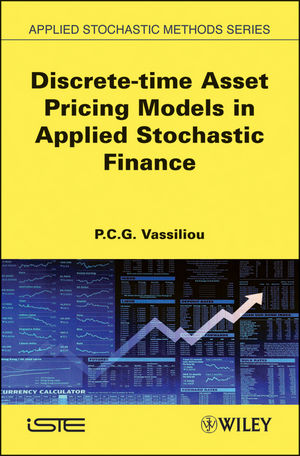Discrete-time Asset Pricing Models in Applied Stochastic FinanceISBN: 978-1-84821-158-2
Hardcover
416 pages
March 2010, Wiley-ISTE
 |
||||||
Preface xi
Chapter 1. Probability and Random Variables 1
1.1. Introductory notes 1
1.2. Probability space 2
1.3. Conditional probability and independence 8
1.4. Random variables 12
1.5. Expectation and variance of a random variable 24
1.6. Jointly distributed random variables 28
1.7. Moment generating functions 32
1.8. Probability inequalities and limit theorems 37
1.9.Multivariate normal distribution 44
Chapter 2. An Introduction to Financial Instruments and Derivatives 49
2.1. Introduction 49
2.2. Bonds and basic interest rates 50
2.3. Forward contracts 58
2.4. Futures contracts 60
2.5.Swaps 60
2.6.Options 62
2.7. Types of market participants 67
2.8.Arbitrage relationships between call and put options 67
2.9.Exercises 69
Chapter 3. Conditional Expectation and Markov Chains 71
3.1. Introduction 71
3.2. Conditional expectation: the discrete case 72
3.3. Applications of conditional expectations 75
3.4. Properties of the conditional expectation 81
3.5. Markov chains 85
3.6. Exercises 131
4.1. Introductory notes 137
Chapter 4. The No-Arbitrage Binomial Pricing Model 137
4.2. Binomial model 138
4.3. Stochastic evolution of the asset prices 141
4.4. Binomial approximation to the lognormal distribution 143
4.5. One-period European call option 145
4.6. Two-period European call option 150
4.7. Multiperiod binomial model 153
4.8. The evolution of the asset prices as a Markov chain 154
4.9.Exercises 158
Chapter 5. Martingales 163
5.1. Introductory notes 163
5.2.Martingales 164
5.3. Optional sampling theorem 169
5.4. Submartingales, supermartingales and martingales convergence theorem 178
5.5.Martingale transforms 182
5.6. Uniform integrability and Doob’s decomposition 184
5.7.The snell envelope 187
5.8.Exercises 190
Chapter 6. Equivalent Martingale Measures, No-Arbitrage and Complete Markets 195
6.1. Introductory notes 195
6.2. Equivalent martingale measure and the Randon-Nikodým derivative process 196
6.3. Finite general markets 204
6.4. Fundamental theorem of asset pricing 215
6.5.Completemarkets andmartingale representation 222
6.6. Finding the equivalent martingale measure 228
6.7.Exercises 238
Chapter 7. American Derivative Securities 241
7.1. Introductory notes 241
7.2.A three-periodAmerican put option 242
7.3. Hedging strategy for an American put option 249
7.4.The algorithm of the American put option 254
7.5.Optimal time for the holder to exercise 255
7.6. American derivatives in general markets 262
7.7. Extending the concept of self-financing strategies 266
7.8.Exercises 269
Chapter 8. Fixed-Income Markets and Interest Rates 273
8.1. Introductory notes 273
8.2. The zero coupon bonds of all maturities 274
8.3. Arbitrage-free family of bond prices 278
8.4. Interest rate process and the term structure of bond prices 282
8.5. The evolution of the interest rate process 290
8.6. Binomial model with normally distributed spread of interest rates 293
8.7. Binomial model with lognormally distributed spread of interest rates 296
8.8. Option arbitrage pricing on zero coupon bonds 298
8.9. Fixed income derivatives 302
8.10. T-period equivalent forward measure 308
8.11. Futures contracts 317
8.12.Exercises 319
Chapter 9. Credit Risk 323
9.1. Introductory notes 323
9.2. Credit ratings and corporate bonds 324
9.3. Credit risk methodologies 326
9.4. Arbitrage pricing of defaultable bonds 327
9.5. Migration process as a Markov chain 330
9.6. Estimation of the real world transition probabilities 334
9.7. Term structure of credit spread and model calibration 337
9.8. Migration process under the real-world probability measure 341
9.9.Exercises 352
Chapter 10. The Heath-Jarrow-Morton Model 355
10.1. Introductory notes 355
10.2. Heath-Jarrow-Morton model 356
10.3. Hedging strategies for zero coupon bonds 362
10.4.Exercises 364
References 365
Appendices 374
Index 395



